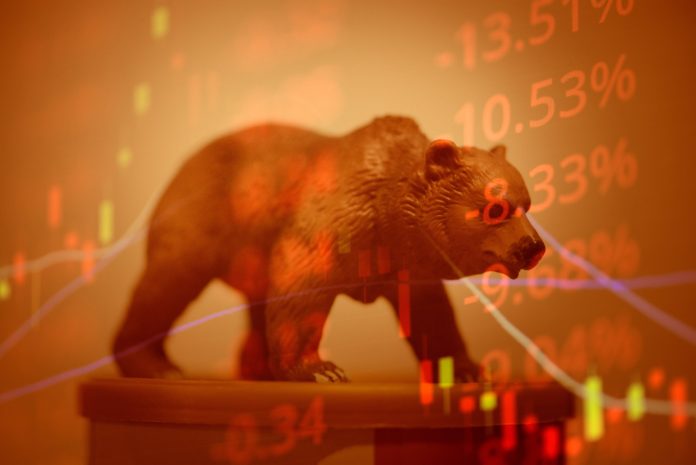What Is a Bear Market?
If you’d have to name three things that will most likely cause the stock market to crash, they would be high inflation, a global pandemic, and war. After the last couple of years, it is not surprising that the market is in turmoil and we entered a bear market territory.
So, what is a bear market? Simply put, it is a sustained period of time where stock prices fall at least 20%.
It’s usually measured by S&P 500 or any other major index that best describes the stock market. During a long bear market, it is typical for market sentiment to be generally low or even hopeless.
A bear market can be caused by a myriad of reasons, including macroeconomic and geopolitical factors, pandemics, wars, or something we don’t even have a word for yet. No matter what the trigger is, the result is ultimately caused by more people selling than buying.
According to the law of supply and demand, a higher price equals lower demand. This is simply because the higher the price of a good is, the more expensive the opportunity cost of acquiring the said good is.
The longer a bull market continues, the fewer buyers there are left. When the relative price of stocks rises higher, the pressure to sell fundamentally overpriced stocks rises.
This leads to more and more investors selling their stock to get as much profit as they can. The more investors sell stocks, the more stock prices fall, and eventually, bear markets occur.
Luckily the bear’s attack is over fairly quickly. According to Bank of America, the average duration of the 19 latest bear markets has been 289 days.
During this time stock prices have declined approximately 37%. The attack may be quick, but quite devastating. For example, when Covid 19 pandemic struck, the Dow Jones Industrial Average declined by 12.9% in a single day.
How to Survive a Bear Market
When a real bear attacks, by the way, there are two kinds of survival tactics. Either you stand your ground and make a lot of noise or lay down and play dead – apparently, it depends on the bear. If you don’t recognize the bear, you usually opt for panic.
Fortunately, in investing there’s only one kind of bear for you to know. Unfortunately, though, there are quite a few different tactics for survival.
Basically, you can buy, sell or hold. The problem for most investors is that they’re not sure what to do and when, so more often not, they resort to panic.
In a bear market, knowledge and patience are key. You should thoroughly know the companies you’re invested in. During a market decline, stock prices don’t necessarily reflect the company’s fundamentals. When terror hits the stock markets, it affects all companies.
Don’t Panic
The most important thing is not to panic. The first reaction to a stock market crash is often to sell everything while it’s still worth something. It’s proven to be extremely difficult to know when to sell and when to buy back the stocks you’ve sold.
If it would be easy to sell high and buy low, everyone would do it. What may be wiser instead is to keep a portion of your portfolio, say 10—20%, in cash for risk management and additional purchases.
The main reason why selling during a downturn is unfavorable is that after a downturn there will inevitably be an upturn. An average bull market lasts longer and has higher returns that surpass the bear market decline by far.
In other words, markets tend to go up in the long run. This is because the companies that make the market grow bigger and make more profits, which increase the overall market size.
Know What You Own
What you can and should do instead, is to find out whether the stocks you own have a fundamental reason for declining or if the stock is just falling with the market.
If the fundaments are in order, the drop in stock price will most likely be a temporary phenomenon and a great opportunity to buy more. When the price of a good company drops, it simply means you get to buy more stocks with less money.
To define whether a stock is a fundamentally sound investment, it helps to learn how to read and interpret the company’s financial statements.
Who Goes a-Borrowing, Goes A-Sorrowing
One of the things to avoid during a bear market is using too much leverage. The returns are never certain but paying the debt back is.
When you have too much debt, it inevitably increases your level of risk and may cause serious problems. Only use a safe amount of leverage, so you’re not forced to sell at an unfavorable time.
Before you consider using leverage, you should define your risk profile carefully.
Stop the press
Stop reading the news for a while. When a panic spreads among investors, it is often the news that amplifies the downward spiral. Nothing makes better headlines than news about an imminent market crash.
For a long-term investor, daily news isn’t usually a relevant source of information.
It is important to remember, that most of the news is just useless noise. Paying too much attention to headlines may derail you from your investment goals and induce panic, which leads us to our next important point.
It’s all about perspective
Maintain long-term perspective. Don’t make short-term decisions if you’re playing a long-term game. What may be devastating for a short-term speculator can be a tremendous opportunity for a long-term investor.
The best way to think of investing is that you don’t buy stocks, you buy the company. If you would be the CEO and the primary owner of, let’s say Coca Cola, you probably wouldn’t sell your company just because the stock has declined for a couple of months.
As a CEO you would probably buy a lot more if you knew your company is fundamentally in great shape and the stock is down 50%.
If a company has a couple of bad quarters during a market downturn, it doesn’t necessarily change the big picture at all. As a long-term investor, you should always think like an owner.
When to Buy More And How
So, as it turned out, you shouldn’t sell a good investment during a bear market, but instead, buy more at a cheaper price. How do you know when it’s the best time to buy? Well, you don’t.
When stock prices plummet, the best thing would be to buy more stocks when they hit bottom. The problem is that achieving perfect timing is pure luck. You can never predict how long and how low the prices are going to decline.
If you feel uncomfortable investing a larger sum at once, it’s wiser to do several purchases over a longer period of time, which is called dollar-cost averaging.
It’s the most efficient way to reduce timing-related risk by reducing the effect of price volatility. It is especially sensible when the market decline is still in its early stages.
Since we’ve established what’s the best way to start making additional buys, the important question is when. There’s no specific point where you should start buying once you’ve entered the bear market territory.
Usually, you can start to make purchases when a stock has declined by 30–50%. This is not to say that it can’t or won’t still go lower, but that’s where dollar-cost averaging will come in.
It is important to remember, that you shouldn’t just blindly buy anything because some stocks are cheap for a reason. The trick is to spot the difference between a good company that’s gone down with the market and a bad company that has fundamental flaws.
If you’re not sure what to buy, it might be wise to invest in indices like S&P 500 index or some other major index. When investing in indices, it’s best not to time at all, but to make regular, monthly purchases to reduce timing risk.
Depending on the amount of cash available, you may want to use your cash sparingly. You don’t want to splurge all your cash prematurely, because you can never know exactly how long the decline is going to last.
It might be the stocks decline another 30% and you have no money left to buy more, so be patient and take your time.
Summary
So, a bear market isn’t necessarily a bad thing. If you are a long-term investor with cash and a patient mind, you can use a bear market to your advantage.
Although a long bear market can be a considerably painful experience, it’s soothing to remember that bear markets are the price you pay for returns.
The stock market is a cyclical place by nature – accept and embrace it.
The most important thing by far is to never panic and sell your stocks. Numerous studies have shown that it’s essential to stay in the market to get the best returns.
According to Bank of America, if you missed the best 10 days in each decade of the past 90 years, your returns would be 28% instead of 17,715%. It pays to stay in the market.
Though past performance is not a guarantee of future results, it’s usually best to stay invested so you don’t miss the inevitable bull markets after the bear markets.
If you’re not sure which securities to buy or which asset allocation to have in a slowing economy, it’s best to invest regularly through a diversified portfolio of different assets. By doing this, you don’t have to worry about firm-specific factors or timing.
Even if you invest in individual stocks, you can allocate a part of your assets to passive index funds to reduce firm-specific risk. Just be sure to avoid the most common mistakes in regular fund investing.
So, bear markets often are the best opportunities to make cheap purchases. When the stock market declines, investors tend to sell and everything goes down.
If you feel you need with your investments, you can always consult a financial advisor.




